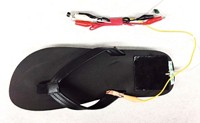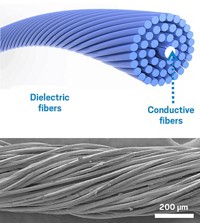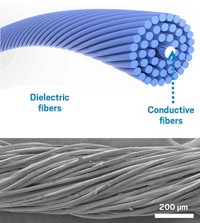Advertisement
Grab your lab coat. Let's get started
Welcome!
Welcome!
Create an account below to get 6 C&EN articles per month, receive newsletters and more - all free.
It seems this is your first time logging in online. Please enter the following information to continue.
As an ACS member you automatically get access to this site. All we need is few more details to create your reading experience.
Not you? Sign in with a different account.
Not you? Sign in with a different account.
ERROR 1
ERROR 1
ERROR 2
ERROR 2
ERROR 2
ERROR 2
ERROR 2
Password and Confirm password must match.
If you have an ACS member number, please enter it here so we can link this account to your membership. (optional)
ERROR 2
ACS values your privacy. By submitting your information, you are gaining access to C&EN and subscribing to our weekly newsletter. We use the information you provide to make your reading experience better, and we will never sell your data to third party members.
Nanomaterials
A Generator Powered By Motion
Nanotechnology: Researchers charge a cell phone using the phenomenon that makes hair stand on end
by Tim Wogan
November 27, 2012
Every time we move our body, we expend a lot of energy. Researchers would love to harvest this energy to generate electricity to power portable electronic devices such as cell phones or medical implants. Now scientists have built such a generator based on the triboelectric effect – the phenomenon behind the static electricity that causes a wool sweater to spark when pulled over a person’s head (Nano Lett., DOI: 10.1021/nl303573d).
The triboelectric effect arises because some materials attract and retain electrons better than others do. When two such mismatched surfaces touch or rub against each other, one surface can grab electrons from the other, leaving one positively charged and the other negative. If the charged surfaces then separate, a voltage develops between them. An electric current flows if the two then reconnect, for instance, through a wire.
Zhong Lin Wang and his colleagues at Georgia Institute of Technology build devices that convert kinetic energy to electricity using the triboelectric effect. Their new design uses a layer of polydimethylsiloxane and one of aluminum, both patterned with bumps to increase their contact area. The researchers joined the sheets at one pair of opposite edges and allowed the sheets to bow away from each other in the center. External pressure can force their centers together, allowing the polymer to grab electrons from the aluminum. When the researchers remove pressure, the two sheets spring apart, creating a voltage across the sheets. The result is a device that converts 10% of incoming kinetic energy into electrical energy.

To test a generator with an area of 9 cm2, the researchers used an electric motor to rhythmically tap the device at a frequency of 6 Hz. This tapping could power a light-emitting diode. The team also could charge an empty cell-phone battery enough to make a call, although the charging process took 85 hours. The researchers calculate that increasing the area of the generator to 100 cm2 and stacking four devices on top of each other should reduce the charging time to around two hours.
The researchers also estimate that by making the generator easier to compress, they should be able to convert 39% of incoming kinetic energy into electricity.
Kinetic energy is freely available on a person, Wang says. For example, the researchers could implant the device in a person’s muscle and when the person swings an arm back and forth, the muscle stretching could power the generator. “Or you could put it in a shoe,” Wang says. “Any place you have this kind of mechanical fluctuation will do.”
Xudong Wang, an expert on harvesting kinetic energy at the University of Wisconsin, Madison, who is not related to the Georgia Tech researcher, says that Zhong Lin Wang’s group has made “a very convincing case” that even small generators have the potential to generate enough power for portable electronics.





Join the conversation
Contact the reporter
Submit a Letter to the Editor for publication
Engage with us on Twitter